Themed collection U.S National Nanotechnology Day 2023

Shape control with atomic precision: anisotropic nanoclusters of noble metals
When plasmonic metal nanoparticles become smaller and smaller, a new class of nanomaterials—metal nanoclusters of atomic precision—comes to light, and recently shape control at the atomic level for new functionality has become an attractive topic.
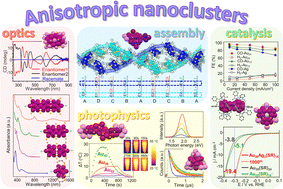
Nanoscale Horiz., 2023,8, 991-1013
https://doi.org/10.1039/D3NH00125C
Transition metal chalcogenides for next-generation energy storage
Transition-metal chalcogenide nanostructures provide a unique material platform to engineer next-generation energy storage devices such as lithium-ion, sodium-ion, and potassium-ion batteries and flexible supercapacitors.
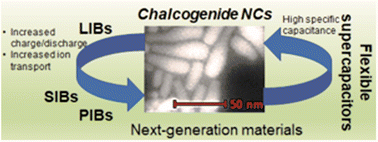
Nanoscale Adv., 2023,5, 2724-2742
https://doi.org/10.1039/D2NA00944G
The development of neutron reflectometry as a probe of the nanoscale structure of polymer thin film systems – founded on the pioneering work of Professor Thomas P. Russell
The pioneering work of Thomas Russell and colleagues helped establish neutron reflectometry as a valuable and often indispensable probe of the nanoscale structure of polymer thin film systems.

Nanoscale, 2023,15, 4725-4737
https://doi.org/10.1039/D2NR06756K
Recent achievements toward the development of Ni-based layered oxide cathodes for fast-charging Li-ion batteries
This review enhances a fundamental understanding of the degradation mechanisms of Ni-based layered cathodes under fast-charging conditions from atomic to electrode scales. Design strategies for enhancing fast-charging performance are also suggested.

Nanoscale, 2023,15, 4195-4218
https://doi.org/10.1039/D2NR05701H
Wearable chemical sensors based on 2D materials for healthcare applications
We provided an overview of recent advances in 2D-material-based wearable chemical sensors for healthcare applications. We also explored the challenges and opportunities associated with designing and implementing 2D wearable chemical sensors.
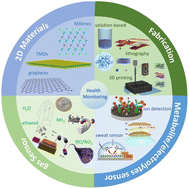
Nanoscale, 2023,15, 3079-3105
https://doi.org/10.1039/D2NR05447G
Surface-assisted self-assembly of 2D, DNA binary crystals
Co-assembly of two different motifs provides a way to increase the structural complexity of DNA nanostructures.
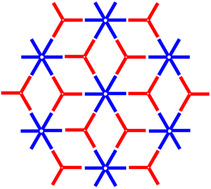
Nanoscale, 2023,15, 9941-9945
https://doi.org/10.1039/D3NR01187A
Unravelling the room temperature growth of two-dimensional h-BN nanosheets for multifunctional applications
Hexagonal boron nitride (h-BN) nanosheets are grown at room temperature by pulsed laser deposition that exhibits remarkable functional properties, creating a scenario for “h-BN on demand” under a frugal thermal budget, essential for nanotechnology.
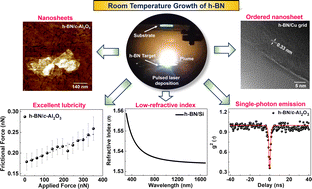
Nanoscale Horiz., 2023,8, 641-651
https://doi.org/10.1039/D2NH00557C
Hardware Trojans based on two-dimensional memtransistors
Hardware Trojans (HTs) have emerged as a major security threat for integrated circuits (ICs) owing to the involvement of untrustworthy actors in the globally distributed semiconductor supply chain.

Nanoscale Horiz., 2023,8, 603-615
https://doi.org/10.1039/D2NH00568A
A cascade nanozyme with antimicrobial effects against nontypeable Haemophilus influenzae
A cascade nanozyme with glucose oxidase and haloperoxidase activities was designed and synthesized, which was shown to generate antiseptic HOBr from a ubiquitous non-ROS, O2. It successfully inhibited growth of a bacterial pathogen and its biofilm.

Nanoscale, 2023,15, 1014-1023
https://doi.org/10.1039/D2NR04306H
Enhanced photochemical activity and ultrafast photocarrier dynamics in sustainable synthetic melanin nanoparticle-based donor–acceptor inkjet-printed molecular junctions
Melanin–TiO2 nanostructured molecular junctions with enhanced photochemical dynamics for optoelectronic and bioelectronic applications.
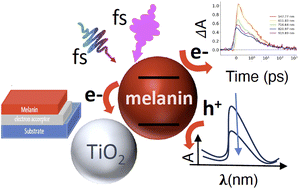
Nanoscale, 2023,15, 14346-14364
https://doi.org/10.1039/D3NR02387G
Enzyme assembly on nanoparticle scaffolds enhances cofactor recycling and improves coupled reaction kinetics
We demonstrate that the phenomena of enzyme enhancement by nanoparticle display can be expanded to enzymatic cofactor recycling along with the coupled enzymatic processes that they participate in.
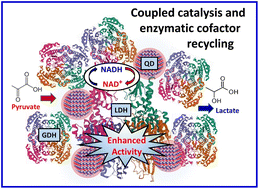
Nanoscale, 2023,15, 10159-10175
https://doi.org/10.1039/D3NR00729D
Vertical van der Waals heterojunction diodes comprising 2D semiconductors on 3D β-Ga2O3
Vertical heterojunctions based on 3D wide band-gap semiconductor, β-phase Ga2O3 and 2D layered semiconductors are demonstrated. Effects of 2D semiconductor, contact metals and β-Ga2O3 crystalline orientation on junction performance are investigated.

Nanoscale, 2023,15, 9964-9972
https://doi.org/10.1039/D3NR01987J
Post-annealing optimization of the heteroepitaxial La-doped SrSnO3 integrated on silicon via ALD
This study demonstrated the successful epitaxy of La-SrSnO3/BaTiO3 on SrTiO3-buffered Si (001) with ALD-deposited La-SrSnO3 and explored the optimization of post-annealing to enhance the capacitance properties of heterostructure.

Nanoscale, 2023,15, 9432-9439
https://doi.org/10.1039/D2NR06861C
DNA-caged nanoparticles via electrostatic self-assembly
Top: Schematic of DNA-caged nanoparticle composite formation. Bottom: U87 cells labeled with fluorescent DNA-caged nanoparticles before and after erasing with single stranded DNA. Scale bar = 10 μm.
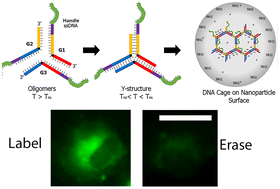
Nanoscale, 2023,15, 9390-9402
https://doi.org/10.1039/D3NR01424J
Electrospun single-phase spinel magnetic high entropy oxide nanoparticles via low-temperature ambient annealing
High entropy oxide nanoparticles (HEO NPs) with multiple component elements possess improved stability and multiple uses for functional applications, including catalysis, data memory, and energy storage.
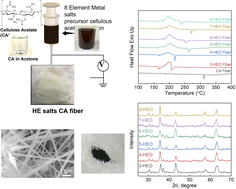
Nanoscale Adv., 2023,5, 3075-3083
https://doi.org/10.1039/D3NA00090G
Plasma-jet printing of colloidal thermoelectric Bi2Te3 nanoflakes for flexible energy harvesting
Bi2Te3 nanoplates were synthesized to develop a water-based nanomaterial ink for a gravity-independent method of additive manufacturing. By optimization of the plasma-jet printer, deposited N-type thermoelectric legs showed significant flexibility.

Nanoscale, 2023,15, 6596-6606
https://doi.org/10.1039/D2NR06454E
Plasmonic nanorod probes’ journey inside plant cells for in vivo SERS sensing and multimodal imaging
Plasmonic silver-coated nanorods were demonstrated to enter plant cells using a multimodal imaging approach. Surface-Enhanced Raman Scattering spectra from dye-coated nanorods were acquired in vivo from whole plant leaves treated with nanorods.

Nanoscale, 2023,15, 6396-6407
https://doi.org/10.1039/D2NR06235F
Continuous manufacturing of highly stable lead halide perovskite nanocrystals via a dual-reactor strategy
Lead halide perovskite nanocrystals possess incredible potential as next generation emitters due to their stellar set of optoelectronic properties.

Nanoscale Adv., 2023,5, 2038-2044
https://doi.org/10.1039/D2NA00744D
Chloride enables the growth of Ag nanocubes and nanowires by making PVP binding facet-selective
We use synthesis, electrochemistry, and DFT calculations to show the presence or absence of Cl− modulates binding of PVP to (100) facets, leading to the formation of nanocubes with Cl−, or truncated octahedra without it.
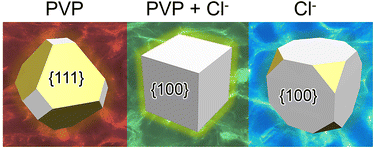
Nanoscale, 2023,15, 5219-5229
https://doi.org/10.1039/D2NR06762E
Inkjet-printed 3D micro-ring-electrode arrays for amperometric nanoparticle detection
Three-dimensional ring electrode arrays can provide means for highly-parallelized nanoparticle-impact electrochemistry within bulk solution.
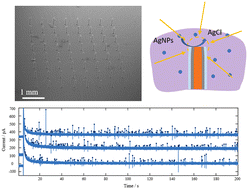
Nanoscale, 2023,15, 4006-4013
https://doi.org/10.1039/D2NR05640B
Mechanobiological modulation of blood–brain barrier permeability by laser stimulation of endothelial-targeted nanoparticles
Picosecond laser excitation of vascular-targeted gold nanoparticles activates multiple mechanobiological pathways in the endothelial cells and induces reversible blood–brain barrier opening.
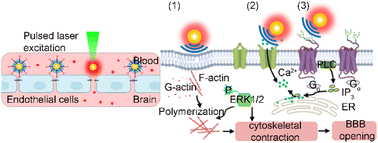
Nanoscale, 2023,15, 3387-3397
https://doi.org/10.1039/D2NR05062E
Insulator-to-metal phase transition in a few-layered MoSe2 field effect transistor
We report an insulator-to-metal phase transition in a few-layer MoSe2 field-effect transistor. The conductivity (shown in figure) becomes metallic at a critical carrier density of 1.2 x 1012 cm-2 and is analyzed using percolation theory.

Nanoscale, 2023,15, 2667-2673
https://doi.org/10.1039/D2NR05019F
About this collection
National Nanotechnology Day is an annual celebration in the US featuring a series of community-led events and activities on or around October 9 to help raise awareness of nanotechnology, how it is currently used in products that enrich our daily lives, and the challenges and opportunities it holds for the future. This date, 10/9, pays homage to the nanometer scale, 10–9 meters. More information is available here: https://www.nano.gov/nationalnanotechnologyday
This year we are celebrating nanotechnology’s achievements over the past 20 years around the theme: "Enabling the Nanotechnology Revolution.” This phrase is inspired by the vision statement for the National Nanotechnology Initiative which is to enable “a future in which the ability to understand and control matter at the nanoscale leads to ongoing revolutions in technology and industry that benefit society."
To celebrate we have put together a series of top articles by US researchers published recently across the Nanoscale journal family. We hope that you enjoy reading them!